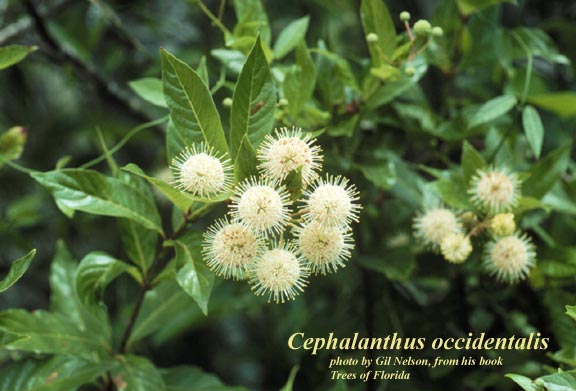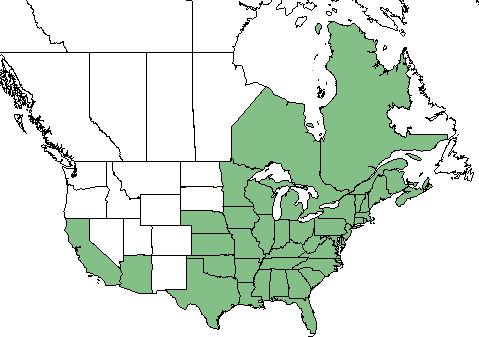Difference between revisions of "Cephalanthus occidentalis"
(→Habitat) |
(→Use by animals) |
||
| Line 48: | Line 48: | ||
The nectar of ''C. occidentalis'' attracts butterflies, bees, and hummingbirds; bees utilize this nectar to make honey.<ref name= "Wennerberg"/> | The nectar of ''C. occidentalis'' attracts butterflies, bees, and hummingbirds; bees utilize this nectar to make honey.<ref name= "Wennerberg"/> | ||
===Use by animals=== | ===Use by animals=== | ||
| − | The seeds of ''C. occidentalis'' are eaten by shorebirds and waterfowl, while white-tailed deer browse the foliage. Wood ducks utilize the plant's structure for cover and protection for their brooding nests. Historically, Native American tribes used this plant medicinally in multiple ways. The bark was deconcocted to be used for washes of sore eyes, anti-inflammation and rheumatism medications, antidiarrheal agents, relief for headaches and fevers, skin astringents, and venereal disease remedies. As well, the bark was chewed to help alleviate toothaches, and the roots were utilized for blood medicine and muscle inflammation.<ref name= "Wennerberg"/> | + | The seeds of ''C. occidentalis'' are eaten by shorebirds and waterfowl, while white-tailed deer browse the foliage. Wood ducks utilize the plant's structure for cover and protection for their brooding nests.<ref name= "Wennerberg"/> It is an adult food source for some Lepidoptera including the Titan sphinx (''Aellopos titan'') and the Hydrangea sphinx (''Darapsa versicolor'').<ref name= "lady bird"/> Historically, Native American tribes used this plant medicinally in multiple ways. The bark was deconcocted to be used for washes of sore eyes, anti-inflammation and rheumatism medications, antidiarrheal agents, relief for headaches and fevers, skin astringents, and venereal disease remedies. As well, the bark was chewed to help alleviate toothaches, and the roots were utilized for blood medicine and muscle inflammation.<ref name= "Wennerberg"/> |
<!--==Diseases and parasites==--> | <!--==Diseases and parasites==--> | ||
Revision as of 16:35, 4 April 2019
Common Names: Common Buttonbush [1], Globeflower [2]
| Cephalanthus occidentalis | |
|---|---|

| |
| Photo by the Atlas of Florida Plants Database | |
| Scientific classification | |
| Kingdom: | Plantae |
| Division: | Magnoliophyta - Flowering plants |
| Class: | Magnoliopsida - Dicots |
| Order: | Rubiales |
| Family: | Rubiaceae |
| Genus: | Cephalanthus |
| Species: | C. occidentalis |
| Binomial name | |
| Cephalanthus occidentalis L. | |

| |
| Natural range of Cephalanthus occidentalis from USDA NRCS Plants Database. | |
Contents
Taxonomic Notes
Synonyms: Cephalanthus occidentalis L. var. occidentalis, Cephalanthus occidentalis L. var. pubescens Raf.
Varieties: none
Description
C. occidentalis is a perennial shrub/tree of the Rubiaceae family native to North America.[1] It contains the poison cephalathin, which induces vomiting, convulsions, and paralysis if ingested. This shrub reaches heights of 6 meters, is multi-stemmed, and stem bases are swollen. Twigs are green when young, have elongated lenticels, 4-sided, and brown and scaly when mature. Leaves whorled or oppositely arranged, glossy in appearance and dark green, developing in May. Flowers tube-shaped, 4 or 5-lobed, reddish to white in color, and develop in dense clusters at branch ends; the long styles on the flower give the pincushion like appearance. Fruit ball-shaped with 2-seeded nutlets enclosed. It can easily be identified by the flower heads, elongated lenticels, or swollen stem bases.[3]
Distribution
C. occidentalis is found in the eastern United States, California and Arizona, as well as eastern Canada. It is also native to Mexico.[1]
Ecology
Habitat
C. occidentalis habitat is primarily wetlands. It can be found on streambanks, depressional wetlands, lakes, and in other standing water. [4] This shrub requires full sunlight for flowering and can withstand habitats of up to three feet of standing water. [1] Soils it can grow on include sandy, sandy loam, limestone-based, medium loam, clay, and clay loam.[5]
Associated species: Fagus grandifolia, Acer rubrum, Acer saccharum, Quercus velutina, Quercus palustris, Nyssa sp., Taxodium distichum, Myrica caroliniensis, Persea borbonia, Ilex sp., Vitis sp., Viburnum sp., Toxicodendron radicans, Sorghastrum nutans, Andropogon gerardi, and Panicum sp.[3]
Phenology
Timing of flowering is from June through September with flowering ranging in color of white to pink.[5]
Seed bank and germination
Seeds of the C. occidentalis need to be germinated in moist soil under full sun or slight shade. [1]
Fire ecology
Intense fires will decrease the response of regrowth, though the C.. occidentalis can resprout after lower intensity burns. [1]
Pollination
The nectar of C. occidentalis attracts butterflies, bees, and hummingbirds; bees utilize this nectar to make honey.[3]
Use by animals
The seeds of C. occidentalis are eaten by shorebirds and waterfowl, while white-tailed deer browse the foliage. Wood ducks utilize the plant's structure for cover and protection for their brooding nests.[3] It is an adult food source for some Lepidoptera including the Titan sphinx (Aellopos titan) and the Hydrangea sphinx (Darapsa versicolor).[5] Historically, Native American tribes used this plant medicinally in multiple ways. The bark was deconcocted to be used for washes of sore eyes, anti-inflammation and rheumatism medications, antidiarrheal agents, relief for headaches and fevers, skin astringents, and venereal disease remedies. As well, the bark was chewed to help alleviate toothaches, and the roots were utilized for blood medicine and muscle inflammation.[3]
Conservation and Management
Herbicides can be detrimental to the species, and springtime flooding can damage it as well.[3] However, a slow release fertilizer can be used for enhancing seed production and flowering.[6] Pruning the plant is not needed for its spread, but can be used in the spring to fix overall shape. When water levels are low, dense shrubs in the fall can be cut back to maintain them.[3]
Cultivation and restoration
A cultivar available is 'Keystone', which was released by the Big Flats New York Plant Materials Center.[6] For restoration, C. occidentalis can be used for erosion control on shorelines. It has a strong base that can stabilize the plant and the shoreline. [1]
Photo Gallery
References and notes
- ↑ 1.0 1.1 1.2 1.3 1.4 1.5 1.6 USDA Plant Database
- ↑ Gee, K. L., et al. (1994). White-tailed deer: their foods and management in the cross timbers. Ardmore, OK, Samuel Roberts Noble Foundation.
- ↑ 3.0 3.1 3.2 3.3 3.4 3.5 3.6 Wennerberg, S. (2006). Plant Guide: Common Buttonbush Cephalanthus occidentalis. N.R.C.S. United States Department of Agriculture. Baton Rouge, LA.
- ↑ Weakley, A. S. (2015). Flora of the Southern and Mid-Atlantic States. Chapel Hill, NC, University of North Carolina Herbarium.
- ↑ 5.0 5.1 5.2 [[1]] Lady Bird Johnson Wildflower Center. Accessed: April 4, 2019
- ↑ 6.0 6.1 USDA NRCS Northeast Plant Materials Program. (2006). Plant Fact Sheet: Common buttonbush Cephalanthus occidentalis. N.R.C.S. United States Department of Agriculture.